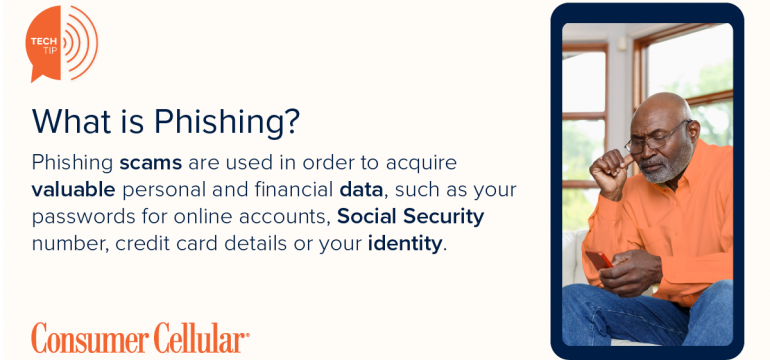These days, it can feel like you can find virtually everything on the Internet. There is something for everyone, from news to shopping to music. Sadly, some aspects of the Internet aren’t as welcoming. One of them is the underworld economy of internet scams. Here at Consumer Cellular, we want your personal information to be kept safe and private. Unfortunately, it can be easy for that information to be stolen from you with a type of scam called Phishing. Below is an introduction to what Phishing is, how it works and what to do so that you can avoid it happening to you.
What is Phishing?
Phishing scams are used in order to acquire valuable personal and financial data, such as your passwords for online accounts, Social Security numbers, credit card details, or your identity. They are mostly associated with email but can come in many forms, including social media messages, pop-up ads, phone calls, and text messages.
How to avoid Phishers?
Recognize Scams
To protect yourself from being scammed, it is best to familiarize yourself with how the scam may look. Phishing scams may contain one or more of the following elements:
- An email from a company or organization you already do business with that has a “Dear Customer” greeting rather than any personalization.
- Generic or general requests, such as “financial issue” or “card declined, please re-enter card information”.
- Alarming threats of drastic consequences involving financial and legal issues if there is not an immediate response.
- Lack of proper grammar and punctuation, many of these scams originate from foreign countries.
If you feel like a message is suspicious, remember to:
- Never click links in email messages from people you don’t know. Clicking a random link could take you to a malware-hosting site or a fraud.
- Never click random links in messages from people you know, as they may have been hacked.
- Make sure to check the site in question if a link you click takes you to a login page.
How to safely share your information online
While there may be instances of using your personal and financial information to pay bills and make purchases, always ensure that your connection is secure and that your site has a legitimate web address. Make sure the website you’re using has HTTPS in the URL; this is the most basic tell to know that the connection is secure.
If you suspect that you’ve received a Phishing email, you can contact the FTC by email at [email protected] or by phone at 877-382-4357, as well as the business that the sender of the email says they represent.

I Think I Understand.
Hi Carolyn, if you have any questions please let me know.
Your tip says, “Make sure the website you’re using has HTTPS in the URL; this is the most basic tell to know that the connection is secure.” When I clicked on to this page, I got a message that said this site doesn’t use https and asked if I’m sure I want to click on it.
Hi Burton, thanks for your post. We appreciate you bringing that to our attention so that we can get that looked into. Thanks!
I would like to know a way to spam phone text messages on my iphone. I know how to separate known from unknown callers’ texts, but I don’t know how to stop the fake texters from coming back.
Thanks.
Hi Marie, thanks for your questions. I’m sorry to hear about the trouble those texts have caused. When those are received we recommend blocking the numbers so that they can’t text you further. You can also look at downloading an app which can help with those messages as well.
I’m able to block unwanted callers on my smartphone service but also have a flip phone with basic consumer cellular service for simple calling needs. Is there any option to block these spammers?